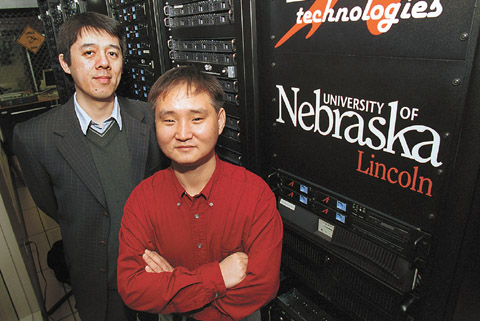| |
|
|

from the issue of March 11, 2004
|

| |
|
|
| |
Study: Silicon can act like metal

BY TOM SIMONS, UNIVERSITY COMMUNICATIONS
Using one large computer, one borrowed graduate student, one good friend and one piece of advice from dear old Dad, a UNL chemist and his team came up with an unexpected discovery: At extremes of size, silicon may behave like a metal.


 
| | UNL Chemist Xiao Cheng Zeng, left, and graduate student Jail Bai stand next to UNL’s supercomputer PrairieFire, which helped them create models of silicon tubes less than a nanometer in diameter. The models showed that the tubes are likely to be conductors. Photo by Brett Hampton.

| |
Xiao Cheng Zeng and his team used UNL’s supercomputer, PrairieFire, to create models of silicon tubes less than 1 nanometer in diameter (that is, less than one-billionth of a meter, essentially making them one-dimensional structures with length but virtually no thickness).

They modeled nanotubes in hexagonal, pentagonal and square configurations and in the process, they found the thinnest known nanotube - the square configuration at less than 0.5 nanometer in diameter. More importantly, when they used the quantum mechanical method to analyze the tubes, they found that they are very likely to be conductors. In other words, they appear not to have the semiconducting properties that have made three-dimensional silicon one of the foundation materials for the modern electronics industry.

The result was published in the Feb. 23 issue of the Proceedings of the National Academy of Sciences, one of the world’s three leading scientific journals, with Nature and Science.

“To find that these tubes are very likely to be metals instead of semiconductors is very surprising,” Zeng said. “Scientists have studied silicon for more than 50 years and it’s the cornerstone material for the modern semiconductor industry.”

The PNAS paper is the third Zeng and his friend, Hideki Tanaka of Okayama University in Japan, have had published in one of the major journals in a little more than three years, following two on low-dimensional water and ice in Nature in 2000 and 2001. And it was while discussing the earlier papers with his father, J.Y. Zeng, a retired professor of quantum physics at Beijing University in China, that Zeng became interested in the quantum systems that led to the most recent discovery.

“Three years ago, when I visited my dad, I talked about these water studies,” Zeng said. “He had studied low-dimensional quantum effects and suggested that I look in that direction. In our work with water and ice, we used the classical physical model without considering quantum effects.”

Considering quantum effects proved to be crucial in the work on silicon nanotubes, but first Zeng needed the assistance of someone with a solid background in solid-state and quantum physics. Zeng is a computational and theoretical physical chemist with the title of Willa Cather professor of chemistry at UNL. But he also has a courtesy appointment in the Department of Physics and Astronomy, which allowed him to hire a graduate student with the necessary background: Jail Bai, a doctoral candidate from South Korea and the lead author of the PNAS paper.

Bai joined Zeng’s lab in 2001 and for nearly three years, they attacked the problem of understanding the sub-atomic behavior of the tiny silicon tubes, finally achieving success last year.

“Bai used the quantum mechanical method to study the problem and from that study we found that these nanotubes are really quite stable - and we found that these tubes are very likely to be metals instead of semiconductors,” Zeng said. “Only quantum physics can tell you the correct behavior of electrons in the nanostructure, and it is the electronic structure that determines whether a material is a metal or a semiconductor. So quantum physics was critical to this.”

Another essential element, Zeng said, was the PrairieFire supercomputer, one of the most powerful on a university campus in the United States.

“These experiments took more than a year on PrairieFire,” he said. “We would have needed more than six on a PC, and that’s beyond a graduate student’s ‘lifetime.’”

Zeng said he’s hopeful that experimental chemists will be able to reproduce his and Bai’s model in the laboratory, but he acknowledged that it will be difficult. Creating nanoscale tubes is commonplace in modern labs, but getting silicon into the tubes will be the problem, he said. The element not only has a high melting point at more than 1,600 degrees Kelvin (more than 2,800 degrees Fahrenheit), but it’s also highly reactive at high temperatures, making it difficult to work with.

He also said it’s far too early to predict what practical uses the tubes might eventually serve. But silicon itself wasn’t isolated as an element until 1824 and it was more than a century after that before its value in electronic circuits was understood.

“We’re just very gratified to find this new nanostructure three years after we entered the field,” Zeng said.
GO TO: ISSUE OF MARCH 11
NEWS HEADLINES FOR MARCH 11
Study: Silicon can act like metal
Area takes holistic view of survey
Facility to work on Valley Fever vaccine
Site features state’s fossils
Sociology focuses on building on department’s strengths
5 areas added to ‘Programs of Excellence’
Addressing water’s legal issues
731651S32998X
|
|
|
|
|
|
|
|